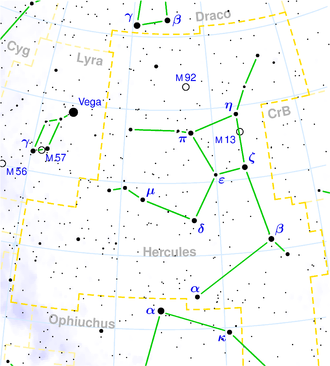NGC 6052
| Galaxy NGC 6052 |
|
|---|---|

|
|
| Photo of the Hubble Space Telescope , NGC 6052-1 (m.) / NGC 6052-2 (left) | |
| AladinLite | |
| Constellation | Hercules |
|
Position equinox : J2000.0 , epoch : J2000.0 |
|
| Right ascension | 16 h 05 m 13.0 s |
| declination | + 20 ° 32 ′ 32 ″ |
| Appearance | |
| Morphological type | Sc + Sc / LIRG |
| Brightness (visual) | 1: 13.8 mag 2: 13.3 mag |
| Brightness (B-band) | 1: 14.5 mag 2: 14.1 mag |
| Angular expansion | 1: 0 ′, 9 × 0 ′, 7 2: 0 ′, 8 × 0 ′, 3 |
| Position angle | 1: 171 ° 2: 175 ° |
| Surface brightness | 1: 13.1 mag / arcmin² 2: 11.6 mag / arcmin² |
| Physical data | |
| Affiliation | LGG 403 |
| Redshift | 0.015808 ± 0.000003 |
| Radial velocity | (4739 ± 1) km / s |
|
Stroke distance v rad / H 0 |
(216 ± 15) · 10 6 ly (66.3 ± 4.6) Mpc |
| history | |
| discovery | William Herschel Albert Marth |
| Discovery date | June 11, 1784 July 2, 1864 |
| Catalog names | |
| NGC 6052, 6064 • UGC 10182 • PGC 57039 • CGCG 137-032 • MCG + 04-38-22 • IRAS 16030 + 2040 • KUG 1603 + 206 • 2MASX J16051287 + 2032326 • Arp 209 • Mrk 297 • VV 86 • GC 4161 , 5802 • H III 140 • | |
NGC 6052 (also known as Mrk 297 , Arp 209 and VV 86 ) is a luminous infrared galaxy (LIRG) about 216 million light-years away. They are two merging galaxies (NGC 6052-1 / 2). In the infrared the object reaches a luminosity of 11 11 L ☉ .
Halton Arp organized his catalog of unusual galaxies into groups according to purely morphological criteria. This galaxy belongs to the class galaxies with irregularities, absorption and resolution .
The object was discovered by Albert Marth in 1864 and is listed in the New General Catalog (NGC 6052). The entry NGC 6064 in NGC also refers to this object; this entry is based on an observation made by Wilhelm Herschel on June 11, 1784.
Web links
literature
- Jeff Kanipe and Dennis Webb: The Arp Atlas of Peculiar Galaxies - A Chronicle and Observer's Guide , Richmond 2006, ISBN 978-0-943396-76-7
